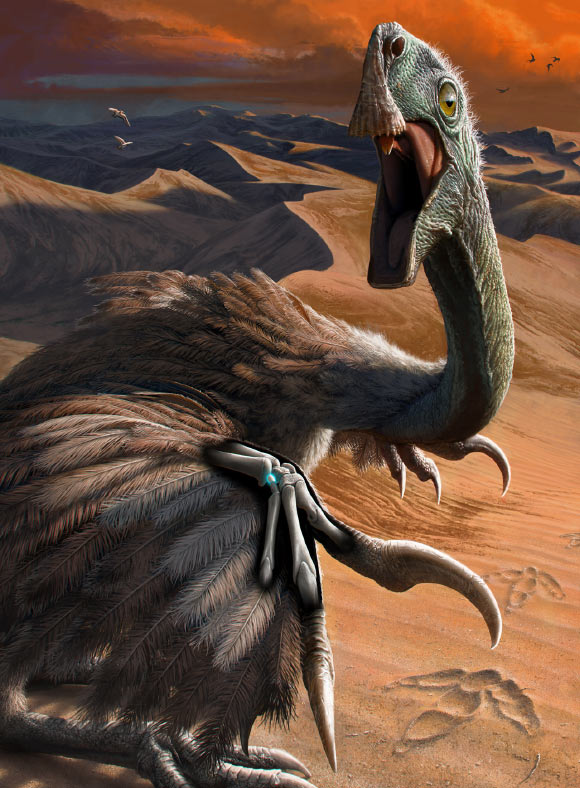A team of paleontologists from Yale University and Stony Brook University made this discovery after examining fossils from two species of bird-like dinosaurs found in the Gobi Desert in Mongolia.
This scene depicts an oviraptorid dinosaur called Citipati being startled while resting on a sand dune. The creature raises its arms in a threat display, which reveals its wrists, highlighting the small migrated pisiform carpal (blue X-ray view) bone. Image credit: Henry S. Sharpe.
For years the identity of one of the carpal bones in the wrist of birds was a scientific mystery, until researchers proved it was the pisiform.
This bone was originally a sesamoid bone like a kneecap and had moved from its original position in the wrist to replace the ulnare, another carpal bone.
Its position in modern birds appears to establish linkages that allow birds to fold their wing automatically when the elbow flexes.
The bone’s shape, with a large V-shaped notch, also allows the pisiform of birds to clasp their hand bones to stop them from dislocating during flight.
Therefore, this bone is an important part of a bird’s forelimb and critical to flight.
“The pisiform, in living birds, is an unusual wrist bone in that it initially forms within a muscle tendon, as do bones like your kneecap — but it comes to occupy the position of a ‘normal’ wrist bone called the ulnare,” said Dr. Bhart-Anjan Bhullar, a paleontologist at Yale University.
“Because it is so intimately associated with arm musculature, its incorporation into the wrist ties the muscular flight machinery to wrist motion.”
“This integration is particularly important for stabilizing the wing during flight.”
In their new study, Dr. Bhullar and colleagues analyzed two Late Cretaceous fossils: an unnamed species of troodontid (bird-like raptor related to Velociraptor), and Citipati cf. osmolskae (oviraptorid with a long neck and a toothless beak).
“We were fortunate to have two immaculately preserved theropod wrists for this,” said Yale University paleontologist Alex Ruebenstahl.
“Wrist bones are small and even when they are preserved, they are not in the positions they would occupy in life, having shifted during decay and preservation.”
“Seeing this little bone in the right position cracked it wide open and helped us interpret the wrists of fossils we had on hand and other fossils described in the past.”
“We believe this is the first time a migrated pisiform in a non-bird meat-eating dinosaur has been identified,” said Dr. James Napoli, a vertebrate paleontologist and evolutionary biologist at Stony Brook University
“While we currently do not know precisely how many times dinosaurs learned to fly, it is intriguing that experimentation with flight in these creatures appears only after the pisiform migrated into the wrist joint.”
“Therefore, it is possible this established the automated mechanisms found in current living birds, though we would need to test this hypothesis with more research and analysis of dinosaur wrist bones.”
Putting their findings in evolutionary context, the authors determined that the pisiform moved into its bird-like position not within birds but by the origin of Pennaraptora, a group of theropod dinosaurs that includes dromaeosaurids like Velociraptor, troodontids and oviraptorosaurs.
Overall, this is the group of dinosaurs in which bird-like traits such as feathered wings began to appear, and in which flight evolved at least twice, and possibly up to five times.
“The topological and functional replacement of the ulnare by the pisiform occurred much deeper in theropod history than has been previously understood and was a stepwise process,” the researchers said.
“Over the past few decades, our knowledge of theropod dinosaur anatomy and evolution has increased exponentially, much of it revealing that classically ‘avian’ traits such as thin-walled bones, an enlarged brain, and feathers, all characterize more inclusive groups of theropod dinosaurs.”
“Our results suggest that the construction of the avian wrist is no exception and follows topological patterns laid down by the origin of Pennaraptora.”
The team’s paper was published July 9, 2025 in the journal Nature.
_____
J.G. Napoli et al. Reorganization of the theropod wrist preceded the origin of avian flight. Nature, published online July 9, 2025; doi: 10.1038/s41586-025-09232-3
